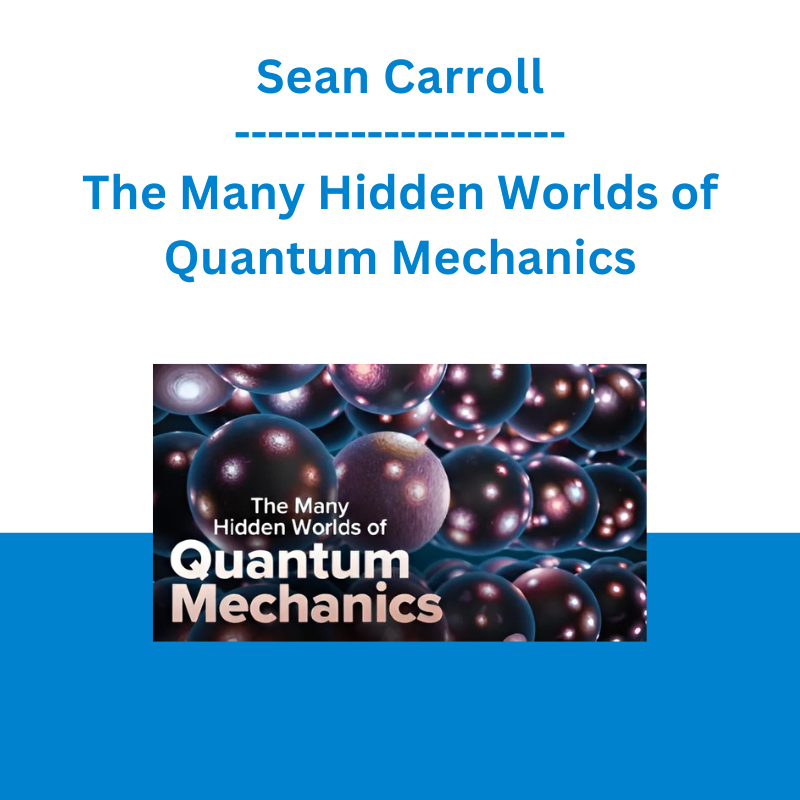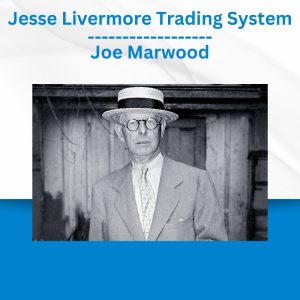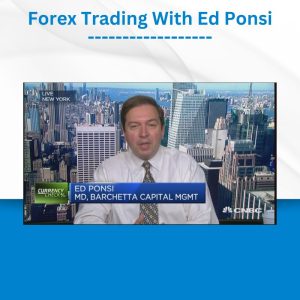*** Proof of Product ***
Exploring the Essential Features of “Sean Carroll – The Many Hidden Worlds of Quantum Mechanics”
The Many Hidden Worlds of Quantum Mechanics
Sean Carroll, Ph.D. Professor, Johns Hopkins University
Professor
Professor Sean Carroll, Ph.D.
We need to push on our understanding of cosmology, particle physics, gravity, not to mention how complexity and entropy evolve through time, and eventually you’ll be able to really understand what our theories predict.
Institution Johns Hopkins University
Sean Carroll is the Homewood Professor of Natural Philosophy at Johns Hopkins University and both a member of the Fractal Faculty and an External Professor at the Santa Fe Institute. He received his PhD in Astrophysics from Harvard University. He is the author of several books, including Something Deeply Hidden: Quantum Worlds and the Emergence of Spacetime, and the host of the weekly Mindscape podcast. He has been awarded prizes and fellowships by the National Science Foundation, NASA, and the Guggenheim Foundation, among others.
Course Overview
Modern physics is filled with ideas that defy common sense, but, nonetheless, have a strong claim to be true. A prime example is Einstein’s twin paradox, about identical twins who age at markedly different rates if one takes a trip at near-light speed. Another is Erwin Schrödinger’s thought experiment involving a cat that is arguably both dead and alive due to a fundamental feature of quantum mechanics.
But no theory strains credulity like “Many-Worlds,” the proposal that we experience only one branch of possibly infinite realities, which sprout like the limbs on a tree, splitting into numberless parallel universes—all of which are equally real. Officially called the Many-Worlds Interpretation (MWI) of quantum mechanics, this seemingly absurd idea may be what’s really going on in our multiverse.
In The Many Hidden Worlds of Quantum Mechanics, noted theoretical physicist, philosopher, and popular author, Professor Sean Carroll of Johns Hopkins University makes an eloquent case that Many-Worlds is the framework that best explains quantum mechanics, which is the science of matter and energy at the atomic and subatomic scales. In 24 accessible and fascinating lectures, he guides you through the history, reasoning, and implications of this bold conjecture. Professor Carroll also covers alternate theories to Many-Worlds and unresolved questions in fundamental physics, making this course a fascinating window into the current state of this exciting field.
Not as Bizarre as It Sounds
How off-the-wall is Many-Worlds? Consider these consequences of the theory:
- Multiverse: Innumerable universes exist simultaneously, and the number is growing exponentially. These universes don’t have a location in space, but space exists inside each, just as in our own universe.
- No Contact: There is no way to travel to these other universes, nor can any signals pass between them. They are isolated and unknowable—yet the simplest version of quantum theory predicts that they exist.
- Duplicates: Countless versions of you exist in these parallel universes. At least, they are you in the sense that each of you shares the same past. However, each version of you is a different person who will experience a unique future.
These claims may sound like science fiction, but there are good reasons to believe them. The Many Hidden Worlds of Quantum Mechanics takes you step by step through the observations, arguments, and counter arguments that first built quantum theory, and then led a group of thinkers inexorably to the Many-Worlds hypothesis. Many-Worlds is by no means the conventional interpretation of quantum mechanics. But as Professor Carroll shows, the extra worlds almost miraculously emerge from the standard equation—whether anyone wants them to or not.
The Birth of Many-Worlds
Many-Worlds is a response to the “Copenhagen Interpretation” of quantum mechanics, named for the city where its principal proponent, Niels Bohr, had his famous research lab in the early 20th century. Designed to account for the strange phenomena observed at the quantum scale, the Copenhagen Interpretation holds that quantum particles or waves exist in multiple states at the same time, as described by the wave function. This wave function is governed by the Schrödinger equation and encompasses all possible quantum states for a system. Upon measurement, the system assumes a definite state, an event that Bohr and his colleagues termed the “wave function collapse.” According to the Copenhagen Interpretation, these multiple states are real physical possibilities that become definite only at the moment of measurement.
In the 1950s, physicist Hugh Everett objected that the wave function collapse was an ad hoc addition to the mathematically elegant Schrödinger equation. Instead, he proposed that the collapse is only apparent, and that we should stick to what the equation tells us: that all possible outcomes continue to evolve in parallel, leading to a branching structure of many non-interacting universes.
Mysteries Solved?
The beauty of Many-Worlds is that it resolves several long-standing paradoxes that have given quantum mechanics its reputation as a theory that not even physicists fully understand. Among these are:
- “Spooky Action at a Distance”: This was Einstein’s term for quantum interactions that appear to take place faster than the speed of light, due to the instantaneous collapse of the wave function.
- Schrödinger’s Cat: This thought experiment describes the puzzling state of a cat before the collapse of a wave function that will decide whether it is alive or dead due to the random release of poison.
- The Observer Problem: In the Copenhagen Interpretation, the mere act of observing instantly collapses the wave function, making a macroscopic world of human thought and action a decisive part of a quantum system.
In each example, Many-Worlds sidesteps these problems by postulating that all possible outcomes take place in separate realities. In the case of “spooky action at a distance,” the consequences of the quantum interaction appear in different universes; therefore, no signal can pass between them, and no faster-than-light travel is involved. For Schrödinger’s cat, it is alive in one universe and deceased in another. And in the observer problem, there is no special role for observers since all outcomes occur.
Physics Has Surprised Us Before
Not surprisingly, many scientists are unsettled by the Many-Worlds approach and have come up with rival theories that deal with the problems of the Copenhagen Interpretation without invoking multiple realities. Professor Carroll introduces a number of these proposals, discussing their strengths while noting that none is as mathematically simple as Many-Worlds. They include:
- Hidden Variables: Pioneered by French physicist Louis de Broglie and American physicist David Bohm, this class of theories adds new variables in addition to the wave function to make it deterministic and to remove the mystery of the Copenhagen model.
- GRW: Ghirardi–Rimini–Weber theory (GRW) endorses the reality of the wave function collapse but makes it spontaneous and random rather than due to the act of measurement. It involves modifying the usual equation obeyed by the wave function.
- QBism: Standing for Quantum Bayesianism, this view uses Bayesian reasoning to make probabilistic predictions about quantum experiments. Its proponents criticize other approaches for objectifying the quantum state, which QBism does not.
And looming over all the lectures is classical physics, the project energized by Isaac Newton in the 17th century, and which reached an unexpected hurdle at the beginning of the 20th century, to be supplanted by quantum theory. The Copenhagen Interpretation then reigned as the most influential view of quantum phenomena for many decades. Its critics have responded with counter proposals, seeking a breakthrough idea to explain the baffling quantum world.
The Many Hidden Worlds of Quantum Mechanics focuses on one of the most spectacular of these proposals. Professor Carroll is at pains to be open-minded, questioning, and skeptical, while marshalling powerful arguments that Many-Worlds—a theory that almost defies belief —should be believed. It wouldn’t be the first time that physics has surprised us.
24 Lectures
1. Why Suppose There’s More Than One World?
Fasten your seat belts and take off into the realm of multiple, maybe even infinite, worlds. Professor Carroll explains how quantum mechanics predicts the existence of a large number of universes parallel to our own. This far-out theory is one of the leading contenders for a rigorous formulation of quantum mechanics. Trace the history of, and motivation for, this idea.
2 The Classical Physics World That Never Was
Investigate the classical picture of reality, which is how physicists thought the world worked before quantum mechanics. Codified by Isaac Newton, classical physics evolved into a nearly unified view based on particles and fields, and it included such revolutionary ideas as Einstein’s theories of relativity. But starting in the early 20th century, scientists began to realize something was amiss.
3 Quantum Worlds Start with Waves and Particles
The widely accepted system of classical physics began to unravel in 1900 when Max Planck proposed an idea that later became known as the quantum. Elaborated by Einstein, this theory held that light waves behave like particles. Later work by Louis de Broglie held that particles sometimes behave like waves. Discover how both ideas were amply confirmed and became central tenets of quantum mechanics.
4 A Wave Function to Describe Particles
Transition from the old quantum theory to full-fledged quantum mechanics with the mathematically elegant concept of the wave function, derived by Erwin Schrödinger in 1925. Professor Carroll guides you through the terms of the Schrödinger equation, which earned a Nobel Prize for Schrödinger and became the basis for wave mechanics—the theory that predicts how quantum systems behave.
5 Copenhagen Says the Wave Function Collapses
Quantum mechanics was disquieting to anyone trained in classical physics. To dispel this unease, Niels Bohr and Werner Heisenberg devised the “Copenhagen Interpretation.” Delve into the strengths and weaknesses of this influential view, which rejects speculation about what’s “really happening.” One reaction was Schrödinger’s celebrated thought experiment involving a cat in mortal peril.
6 Is the Wave Function Real?
Consider exactly what Heisenberg meant by his uncertainty principle, which is often misstated, even by physicists. Go deeper into wave-particle duality, studying the famous double-slit experiment, which shows light behaving simultaneously as a wave and a particle. Discover why a realist perspective on Schrödinger’s wave function dissolves some of the key paradoxes of quantum mechanics.
7 Uncertainty in Action with Spin and Qubits
Explore the fundamental quantum property of particles known as “spin,” which can come in binary states, like the 0 and 1 bits in digital computing. For the purposes of quantum computing, spin can serve as a “qubit” to encode information at the subatomic level. Learn how spin makes the uncertainty principle much easier to understand and provides deep insights into the nature of the quantum world.
8 Quantum Entanglement and Action at a Distance
Focus on Einstein’s objection to a specific feature of quantum mechanics called entanglement, which he termed, “spooky action at a distance.” When two particles are entangled, no matter how far apart they are, if you measure the property of one, you instantly know the corresponding property of the other. In his controversial “EPR” paper, Einstein tried to use this feature to argue that quantum mechanics must be incomplete.
9 Entanglement Leads to Many Worlds
Use the concepts developed in the course so far to learn how physicist Hugh Everett arrived at a bold new approach to quantum mechanics. Called the Many-Worlds Interpretation, it holds that the wave function represents reality and evolves smoothly into multiple distinct worlds when a quantum measurement takes place. Contrast Everett’s straightforward idea with the opaque Copenhagen Interpretation.
10 Decoherence Explains Branching Worlds
Focus on decoherence, which does the same work in Many-Worlds as the collapse of the wave function in the Copenhagen Interpretation. Both explain what happens when a measurement is made, but in Many-Worlds the mechanism is more consistent with the underlying physics. Then, see how decoherence is the gateway to multiple branching worlds, which differ from the cosmological idea of the multiverse.
11 How Entanglement Powers Quantum Computers
Many-Worlds theorist David Deutsch helped pioneer quantum computing, which he argues is an outgrowth on the Many-Worlds Interpretation. Investigate the principles behind quantum computing, comparing it to classical computing. Discover that the big difference is the architecture of logic gates. See how quantum computers can surmount this obstacle and excel at certain types of calculations.
12 Too Many Worlds! Five Objections Answered
The Many-Worlds view seems to defy common sense. Why can’t we see the other worlds? And don’t they violate the laws of physics and other rules of nature? Professor Carroll answers five major objections, concerning the philosophical concept known as Occam’s Razor, the problem of time asymmetry, the possibility of infinity, plus scruples about immortality and energy conservation.
13 Testing the Many-Worlds Interpretation
Address another objection to the Many-Worlds Interpretation: its testability. This refers to philosopher Karl Popper’s famous falsifiability criterion, which discounts any theory that can’t in principle be proven false. The proliferation of worlds that can’t ever be observed might seem to qualify Many-Worlds as unfalsifiable, but Professor Carroll shows that it is testable where it counts.
14 Where Does Probability Come From?
Yet another hurdle for Many-Worlds is the origin and nature of probability. The Copenhagen version of quantum mechanics is fundamentally probabilistic, rather than deterministic. This is a key feature in its success. By contrast, Many-Worlds is deterministic. We can derive an understanding of probability by thinking about where we are in the quantum wave function.
15 Quashing Worlds with Wave Function Collapse
Given the mind-boggling implications of Many-Worlds, many physicists have sought plausible alternatives. In this lecture, consider the possibility of altering the Schrödinger equation—the jumping-off point for Many-Worlds. Investigate two proposals that try this tactic: GRW (named after its inventors, Ghirardi, Rimini, and Weber) and CSL (Continuous Spontaneous Localization) theory.
16 Blocking Worlds with Hidden Wave Variables
Does the wave function tell the whole story? Explore the hidden variable theory, devised by Louis de Broglie and refined by David Bohm. According to this view, particles are guided by pilot waves constructed from the wave function. The “hidden variables” are the precise positions of particles, which are being guided by the pilot waves. Learn why some critics call the idea “Many-Worlds in denial.”
17 Mind before Matter in Quantum Theory
Since quantum mechanics and consciousness are both mysterious, could they be connected in some way? Examine several arguments that relate quantum phenomena to the involvement of conscious observers. The Copenhagen Interpretation is particularly open to such speculations. Also, look at Quantum Bayesianism, or QBism, which sidesteps quantum paradoxes by dispensing with the idea of objective reality.
18 The Quantum Emergence of the World We See
How does the structure of observed reality emerge from the wave function in Many-Worlds? In other words, where do the worlds come from? This question relates to the “preferred basis” problem that attempts to link the quantum realm to everyday macroscopic objects. See how Schrödinger’s clever thought experiment involving a cat provides a conceptual tool for solving this puzzle.
19 The Challenge of Quantum Gravity
Quantum theory accounts for a remarkable array of particles and forces—but not gravity. Learn why constructing a successful theory of quantum gravity has vexed physicists for nearly a century. Professor Carroll lays the groundwork for discussing the Many-Worlds perspective on gravity by focusing on two popular alternative theories: string theory and loop quantum gravity.
20 Space Emerges from Entanglement
Starting with the basic ingredients of quantum theory—wave functions, Schrödinger’s equation, and entanglement—and following the Many-Worlds approach, probe this question: What circumstances lead to emergent branches of the wave function that look like matter moving in curved spacetime—that is, in gravitational fields? Find that gravity may be a natural consequence of quantum mechanics.
21 The Quantum Emergence of Time
As space might be an emergent property of quantum entanglement, could the same be true of time? Divide a wave function into subsystems and watch how the rest of the universe becomes entangled in a manner that can be interpreted as time passing. Along the way, learn the ideas behind the Wheeler-DeWitt equation, which helped define the “problem of time.”
22 Free Will, Determinism, and Many-Worlds
Get philosophical by probing a pair of profound questions that arise from the far-out implications of Many-Worlds. Are multiple branching worlds caused by our decisions? Is human free will possible, especially in light of the deterministic nature of Many-Worlds? Professor Carroll analyzes the way the macroscopic world of human thought and action interact with the quantum realm.
23 What Happens to Ethics under Many-Worlds?
A theory in which every moral act entails an immoral one taking place in a branching universe is rife with ethical quandaries. Now, consider whether you could be moral in each of the universes of a Many-Worlds scenario—or if that’s even possible. One stumbling block is imagining that the version of you that took a branching path is actually you. You may share a past, but the two of you are really different people.
24 A Future Renaissance for Quantum Mechanics
Many-Worlds and competing theories on the foundations of quantum mechanics may seem essential for our understanding of reality, but they were long ignored by no-nonsense practicing physicists. Close the course by witnessing how the tide is turning, as it becomes increasingly clear that the foundational issues are likely the key to unlocking the outstanding mysteries of the cosmos.
What Will You Learn?
- Learn how the equation that governs quantum mechanics predicts a mind-boggling number of non-interacting universes
- Discover how Many-Worlds resolves the paradoxes that plague quantum theory
- Survey alternatives to Many-Worlds, including the Copenhagen Interpretation that was the most influential model for many decades
- Cover the historic background for these developments, including classical physics
- Consider the implications of Many-Worlds in philosophy and ethics
- Explore the impact of Many-Worlds on unsolved questions in physics, including quantum gravity and the origins of space and time
Please see the full list of alternative group-buy courses available here: https://lunacourse.com/shop/










 Jesse Livermore Trading System - Joe Marwood
Jesse Livermore Trading System - Joe Marwood  Sarah Doody - The UX Portfolio Formula
Sarah Doody - The UX Portfolio Formula  Jim Corrington - MEADOWS: Recipe for Recovery
Jim Corrington - MEADOWS: Recipe for Recovery  Jennifer Cellar & William “Barry” Inman - Aging Patients Fall Prevention and Infection Control Challenges
Jennifer Cellar & William “Barry” Inman - Aging Patients Fall Prevention and Infection Control Challenges  Ed Ponsi - Forex Trading
Ed Ponsi - Forex Trading  Hemi Sync - Ancestral Healing: Healing Your Ancestral Mother Wound
Hemi Sync - Ancestral Healing: Healing Your Ancestral Mother Wound  Robert Allen – Paid to Pitch
Robert Allen – Paid to Pitch  Emanuele Bonanni - My Trading Way
Emanuele Bonanni - My Trading Way  Oliver Velez - Essential Strategy Of Trade For Life
Oliver Velez - Essential Strategy Of Trade For Life  Jen Rozenbaum - Building a Successful Boudoir Business
Jen Rozenbaum - Building a Successful Boudoir Business  Jim Heavey - Drawers for Cabinetry & Fine Furniture
Jim Heavey - Drawers for Cabinetry & Fine Furniture  Stone River Elearning - Overcoming Sales Objections
Stone River Elearning - Overcoming Sales Objections  Fred Haug - Virtual Wholesaling Simplified
Fred Haug - Virtual Wholesaling Simplified  Shari Murgittroyd - Maximize Telehealth: Tapping into Your Clients World to Improve Therapeutic Outcomes - PESI
Shari Murgittroyd - Maximize Telehealth: Tapping into Your Clients World to Improve Therapeutic Outcomes - PESI  Michael Munion - BT12 Short Course 54 - Love and Intention: Improving Strategic Outcomes
Michael Munion - BT12 Short Course 54 - Love and Intention: Improving Strategic Outcomes  Can Masters - ADVANCED YOGA WORKOUT INSTRUCTIONAL VIDEO SERIES
Can Masters - ADVANCED YOGA WORKOUT INSTRUCTIONAL VIDEO SERIES  Rick Collingwood - Pain Free
Rick Collingwood - Pain Free  Peggy McColl - The Power Life Script
Peggy McColl - The Power Life Script  Brian Tracy - The 6-Figure Speaker Virtual Training Course
Brian Tracy - The 6-Figure Speaker Virtual Training Course  Evidence-Based Treatment Planning for Anger Control Problems - Timothy Bruce & Arthur Jongsma
Evidence-Based Treatment Planning for Anger Control Problems - Timothy Bruce & Arthur Jongsma  Toshko Raychev - Profit System + ITF Assistant
Toshko Raychev - Profit System + ITF Assistant  Teresa Garcia-Sanchez - IC19 Workshop 39 - Life is a Permanent Grief
Teresa Garcia-Sanchez - IC19 Workshop 39 - Life is a Permanent Grief  Julie Stoian & Cathy Olson - Launch Gorgeous - Funnel Gorgeous Bundle
Julie Stoian & Cathy Olson - Launch Gorgeous - Funnel Gorgeous Bundle